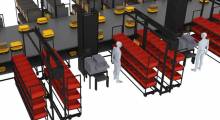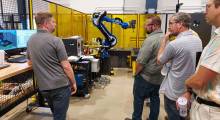Global uncertainties shaped a major drop in robotics and automation spending in 2023. Amidst pandemic recovery efforts, invasions, global inflation and other uncertainties, A3 reported that robot orders dropped 37% in the first half of 2023 compared to the same timeframe just one year earlier.
A record 2022 in robot spending was met with a severe downturn 12 months later, and as organizations around the globe plan and execute their 2024 spending, it’s still a time of uncertainty.
HowToRobot, a global robotics platform connecting prospective buyers and vendors, predicts that 2024 will be a year of strategic investment in automation, as organizations look to navigate these economic waters.
Robotics 24/7 spoke with HowToRobot CEO Søren Peters and platform director Mette Klausen to discuss these reports, along with how companies can evaluate the marketplace with robot and automation orders moving forward.
Automation in demand
When you evaluate the market dip in 2023 and look ahead to 2024, how has the pandemic and other global economic uncertainties affected purchasing power in the robotic and automation industries?
Peters: I think, coming out of COVID and the following labor shortages, many realized, “If we had automated sooner, we would be in a much better position today.” This realization drove many investments in robots – some hasty and some not leading to the outcome that was hoped for.
My take on it would be that many - following these massive investments - were adjusting to the situation and making sure they got a return on the investments. At least, that's what we hear from many clients: The rush to automate has cooled down a little, although the need for it is still strong.
A lot of talks with clients are like this: “We still need automation and are still going to invest. But we also need to make sure, there’s a plan in place next time, that we are going for the opportunities with the best return for our business, and that everyone is on board.” They started on that journey in early 2023, and then interest rates boomed along with all the geopolitical events that shook up supply chains.
This uncertainty made businesses cut down on investments and build up war chests. I don't think the need for robots changed much. Robot sales just followed the general investment appetite of 2023. In that sense, both 2023 and 2022 were outliers and hard to compare with. We will see how this evolves in 2024, but the underlying need for robots and automation is still growing.
How does the perception of automation “taking jobs away” from humans hurt this spending?
Peters: The advantage of HowToRobot is that we can observe the market neutrally. Every year, we see hundreds of clients testing the waters on their needs for automation. Not one that we asked, not one, do this because they want to fire people.
Mass adoption has to be based on knowledge… This will take time. And that is the only thing we can't automate. We can help. We can increase knowledge. We can give them options. We can help them translate how those solutions solve their needs. But you cannot push these decisions. It will come over time.
Klausen: Overall, one of the major concerns for businesses is the labor shortage. If you can't find the right people and the orders keep coming in, how can you make the production line keep up? So, of course, businesses want to reduce the human involvement in some tasks because they need those employees to take on other, more valuable tasks… Basically, you are moving people around to keep up with the orders that are coming in.
Doing this also can also improve the working environment by freeing people from taking on the most physically demanding tasks involving, for example, highly repetitive motion, heavy lifting or taking place in hazardous environments. Because of this, robots and automation are often welcomed.
People are still people buying robots
How are organizations having financial discussions about robotic investments?
Peters: Let’s say you're looking to automate a palletizing job. Maybe you meet a guy at a trade show with a palletizer. You barely know the guy, and he wants $400,000 for it. How do you deal with that?
It’s hard to get financing for the robot for several reasons. It's hard for the robot integrator to get financing for his business because robots are still new and unknown to most banks. That means that the integrator has to buy the parts for the palletizer upfront.
Now, that also means that you, as a customer, have to help him pay for those parts upfront. You're maybe paying 40% upfront to a guy you haven’t met until a trade show and a few meetings. That’s 40% upfront for a thing you still haven’t seen. And then he may want perhaps an extra 30% before shipping it. That's very often what we see. So, now you're paying 70% - or even up to 90% - before you get it installed. … And your boss is looking over your shoulder. These are some of the things that can make the financial discussions challenging.
Klausen: Another common discussion is how to justify the investments. When we look at it and talk about reducing people on production lines, it’s because you have to have a baseline of what you can gain financially from automating. Freeing up manual labor is one factor. Other common ones are increasing productivity and capacity, improving quality and reducing errors and waste.
All of this is needed to calculate the business case and know how much you can actually justify spending on a robot. When businesses look broader at the benefits of automating, the business case can also get a lot better.
What problems still exist on purchasing decisions for robotics and automation?
Peters: One of the things that we've taken away from 2023 as a company is that the conversations between buyers and sellers often start out with being very technology-based and “look what this can do.”
People often find robots fascinating. After the first impressions, most conversations are about, “But do we need it?” and “How can we make sure it can fix the things we need it to do?”
We see many promising technologies, and a customer base that some of the time are not there yet. They are looking for a solution to their problem, and are less interested in whether it’s a six-axis robot or a SCARA robot. As the market matures, we will see buyers and sellers finding more common ground here.
Klausen: Some of the things we also see in the market is the need to define the adequate automation degree for your automation project. This can be difficult to do without help from experts. Having unrealistic expectations can lead to a project scope that isn't compatible with currently available technology.
This can make it difficult to get solution proposals from vendors - or you may end up buying a solution that is too expensive or your production does not support.
What does the future hold in 2024 and beyond for robotics and automation spending? Is 2023 an anomaly?
Peters: I don't think the need for robots has weakened. I think robot sales followed the general investment appetite of 2023… You've got two major outliers one year after another… If you compare 2022 and 2023, and look at them in a graph a couple of years from now, it’s going to look like a small bump there. In general, the need for automation has been - and is - growing, and we expect this pattern to continue in the coming years.
Klausen: I agree. The main question is how we can support the alignment between buyers and sellers to enable adoption in the best possible way.
About the Author
Follow Robotics 24/7 on Linkedin
Article topics
Email Sign Up

















